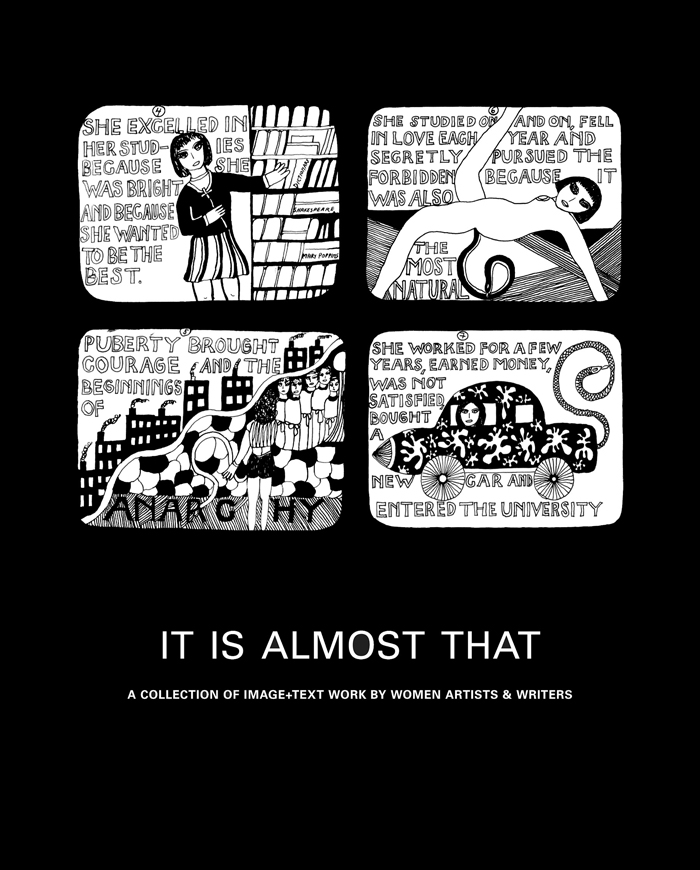
It Is Almost That: A Collection of Image+Text Work by Women Artists & Writers, ed. Lisa Pearson, Siglio, 2011.
It Is Almost That is a collection of “image+text work by women artists and writers” that includes works made in English-speaking countries between the 1940s and its year of publication, 2011. In the book’s afterword, editor Lisa Pearson describes the volume as the first of a series of books dedicated to image and text work, with its focus on women as a gesture towards correcting the “deep gender inequality when it comes to the coveted real estate of exhibitions and publications.”1 With that Pearson dispenses with the issue of the book’s all-female roster. She could have gone on to say more, specifically about the lack of women artists in the scholarly discourse around Conceptual art. However, we find the rest of Pearson’s argument in the collection itself: its inclusiveness and sampling nature expands the established parameters of the discourse around image and text works, some of which have to do with gender. In addition, Siglio’s series is particularly relevant to this moment when conventional journalism—a field full of images and texts in perpetual counterpoint—must be challenged.
The declaration of the collection’s title suggests some of the concreteness, the “I Am Here”-ness,2 that characterized 1960s and 1970s Conceptual art.3 In this case, however, “It Is Almost That” is a statement that invokes hybridity and ambiguity, rather than a definitive, obstinate claim for the transparency of language or image.4 In another gesture towards in-between-ness, all of the images are printed in shades of gray. Significantly, the texts in all of the works reproduced in the book are fully legible. As a result, the collection can be experienced like an exhibition, but in this book format one has the time and inclination to read all the text fully, rather than pausing in front of a language-heavy drawing in a gallery, shifting from leg to leg and wondering what’s on the next wall. Thus the lateral nature of the annotations that appear before each of the twenty-six works—in most cases they are excerpts from artist statements—is welcome.
Three of Adrian Piper’s Political Self-Portraits (1978–80) are the first works reproduced in the book.5 Their substantive presence and alpha position announce immediately that the collection accepts that the personal is political and vice versa. As one of the only women canonized for her text and image work from the 1970s and 1980s, Piper’s placement at the beginning of the collection also points to this period and, perhaps, its relative lack of historicized women artists. Most importantly, however, these works by Piper defy being categorized as just one thing. Indeed they can be identified as Conceptual art as well as a precursor to 1990s Identity art. The self-portraits are, obviously, autobiographical, while at the same time playing with the relationship of the imaged body to the overlaying text. Pieces like the Political Self-Portraits series suggest that history’s well-defined genres are porous and exemplify how the combination of text and image can suggest new strategies for articulating the self in public.6 These propositions remain relevant and revelatory decades later.
After the Piper pieces come works from prior and successive decades by producers who identify as artists, writers, and, in the case of the Bambanani Women’s Group, citizen workshop participants. The time span covered by the works in It Is Almost That establishes that the combining of language and image is something that women did provocatively long before the 1960s and 1970s. For instance, He Disappeared into Complete Silence (1947) by Louise Bourgeois unapologetically plays with misalignment between image and caption or, if you’re coming from the literary side of things, between text and illustration. These modest works speak to the destabilizing effects of World War II on the psychology of individuals as well as on aspects of the material world such as architecture. Unica Zurn’s drawings from The House of Illnesses (1958), made in a fevered state, address the pathologizing of the body in a postwar time period. Her compositions shift between sprawling, annotated doodling and diaristic writing and point to ways in which the different states of health and illness are determined by and, at the same time, are incomprehensible to established institutions. For her Fallen project (2004–ongoing), Jane Hammond creates “facsimiles of autumn leaves and inscribe[s] each of them with the name of an American soldier who has died [in Iraq].” The amassed prints accumulate into large installations that operate more sculpturally than textually, where the “text” functions as a placeholder for very specific bodies and lives. The artist’s act of assigning each name a painstakingly rendered autumn leaf—this time death is part of nature’s cycle—emphasizes the hand we have in maintaining the war machine and its assumed inevitability.
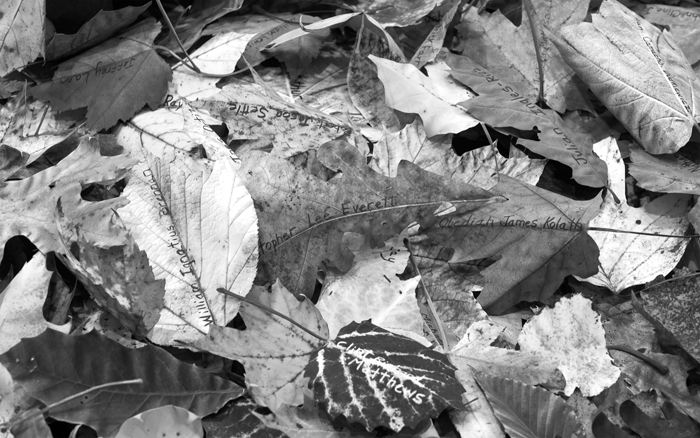
Jane Hammond, Fallen, 2004– ongoing. Each individual leaf is a color inkjet print printed from a digital file, recto and verso on cut archival paper with matt medium, Jade glue, fiberglass strand, sumi ink, and additional handwork in acrylic paint, gouache, and handmade cotton rag paper. Dimensions variable. Collection of the Whitney Museum of American Art, New York. Image courtesy of the artist. Published in It Is Almost That: A Collection of Image+Text Work by Women Artists & Writers, ed. Lisa Pearson, Siglio, 2011
The presentation of so many different kinds of approaches to the image and text combination puts the emphasis on the genre’s possibilities rather than any definitive arguments made throughout its relatively long history. You can finish the Siglio book with an expanded idea of what this genre is, and an increased awareness of some of the more pointed arguments it does make. Susan Hiller, whose Ten Months (1977–79) can be found in the book, offers a concise declaration, in the negative, of what is at stake in some of these efforts. An excerpt from a piece of writing titled “Women, Language and Truth” considers the pros and cons of using the conventional languages (verbal and visual) of our culture. To refuse them is to risk “a loss of certainty and public effectiveness and the appearance of consistency.” Nevertheless she urges artists to resist the dominant conventions, for “the greatest self-betrayal for an artist is not indulging in anarchic or careless opposition to rational politics, but in fashioning acceptable SEMBLANCES of truth.”7 When applied to the work in It Is Almost That, this statement helps us to see how some works are not only anarchic and irrational but also how they propose other ways of reading, demonstrating how this anarchy can shift our perceptions of other instances of image and text, such as those within journalism or advertising.
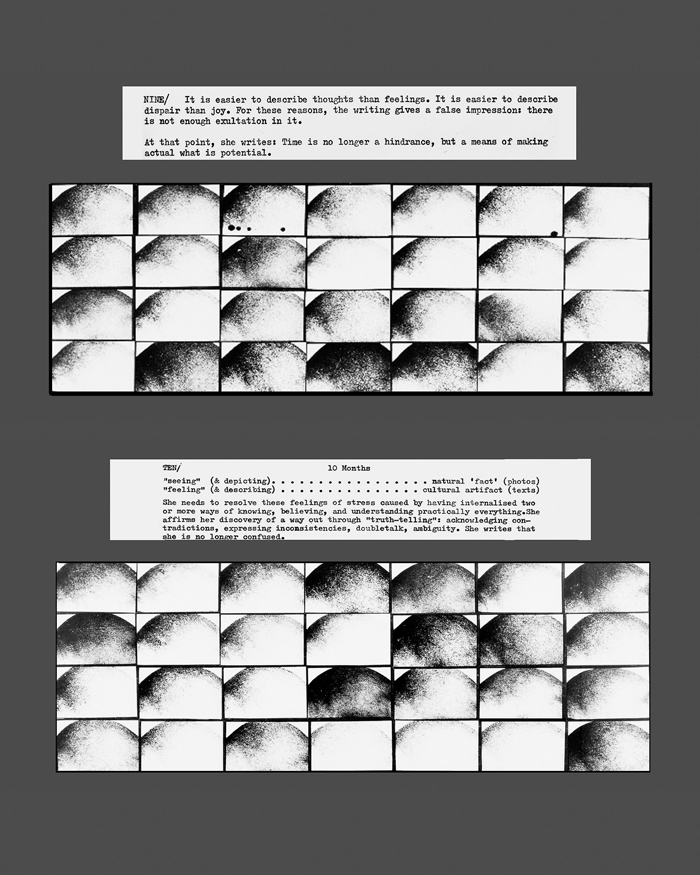
Susan Hiller, Ten Months, 1977–79. Black and white photographs and text. Image courtesy of the artist. Published in It Is Almost That: A Collection of Image+Text Work by Women Artists & Writers, ed. Lisa Pearson, Siglio, 2011.
When considering It Is Almost That as a whole in relation to Hiller’s statement, the sense of cohesiveness suggested by the gray-scaling of all images feels restrained and confining. The color (or absence of color) in the original works would have been a strong indication of the varied eras and strategies gathered together in the collection. That simple act of gathering the works without the formal intervention of removing all color would no doubt have made visible profusions, protrusions, and contradictions. It would have allowed for not only the connections but also the edges between works to be more immediately visible.
The individual art works in the collection that overtly reference the conventions of journalism are some of the most immediately relevant to the United States in an election year. Suzanne Treister’s Alchemy drawings (2007) reorder the front pages of newspapers into hand-drawn reports gurgling with alchemical and explosive potential. Reading them one can re-imagine a kind of reportage where the journalist’s agenda and institutional affiliations are diagrammed alongside the news. Then there are the Bambanani Body Maps (2001–06), which in real life are 72 × 40 inches in size. They present a kind of annotated mirror for the reader’s body. Produced in art therapy workshops by South African women who are HIV-positive, each map presents the highly personal thoughts and commentary of the person whose body is rendered. The reader moves from limb to limb, relating to the idiosyncratic data through his or her appendages. This act of empathic reading has the potential to create bonds between author and reader, journalist and citizen, that give the topic at hand new, embodied, life. Fiona Banner’s excessive “reportage” on Vietnam films, resulting in her book The Nam (1997), addresses the now too familiar trope of war movies writing the history of a conflict. Banner wrote blow-by-blow descriptions of the six movies as she watched them repeatedly, creating an experiential, durational performance document. The redundancy of this act loudly echoes the contemporary news cycle repetitively dosed with violence. These three works in particular play with how commentary about current events is made visible (or not) in a public sphere.
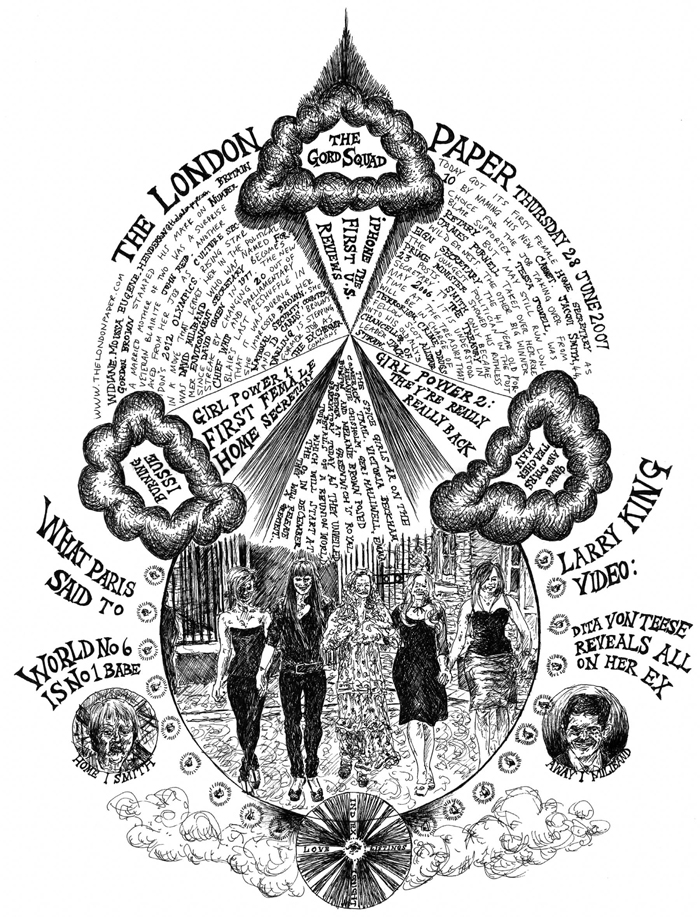
Suzanne Treister, Alchemy, 2007. Rotring ink drawing on Arches paper, 16 1⁄2 × 11 7⁄10 inches. Image courtesy the artist, Annely Juda Fine Art, London, and P.P.O.W. Gallery, New York. Published in It Is Almost That: A Collection of Image+Text Work by Women Artists & Writers, ed. Lisa Pearson, Siglio, 2011.
Although less overt in their reference to reporting, Hannah Weiner’s journal entries in Pictures and Early Words (1972) present a way of accounting for lived experience that plays with the dominant conventions of diary entries. Some of the most straightforward text works in the overall collection, the writing gives an account of Weiner’s daily life in the early 1970s and of her self-proclaimed clairvoyance, which was presumably partially facilitated by the onset of schizophrenia. She records her streams of description and interpretation in all their anarchic banality, making legible not only what she was thinking but how her senses apprehended. There is no mistaking her writing for a semblance of anything—she is at the center of its universe. She does not assert, recommend, or, even, propose: here the irrational is believable precisely for its solipsism.
The body literally traced to create a rendering to scale, an author voluntarily trapped in a movie theater for days, the diagrams that require you to twist and turn your head and neck in order to read the breaking news of years ago: these works explore the physical and/or time-based experience of apprehending knowledge. The positioning and repositioning of the body pushes us to consider from where we stand in order to make our own observations. The body, and its sensory experience making itself visible again, is inextricably intertwined with voice and testimony, most specifically in the era we currently occupy. This past year has been one in which productive and protected speech has been overtly contested, and journalism’s fallacies have been made visible time and time again. Residents of the United States are confronted with the harsh realities of free speech being eroded and recalled. Proposed legislation is proving the vulnerability of the Internet, calling into question the Web’s so-called democracy of self-expression.8 Who speaks for whom is a pressing issue. And how that process is represented in media is just as vital. The Occupied movement’s General Assembly and its embodied, horizontal system of communication brought to the fore the issue of public speech and one-to-one representation. The current presidential election highlights these issues, too, albeit in a more uninspiring and deflating manner.
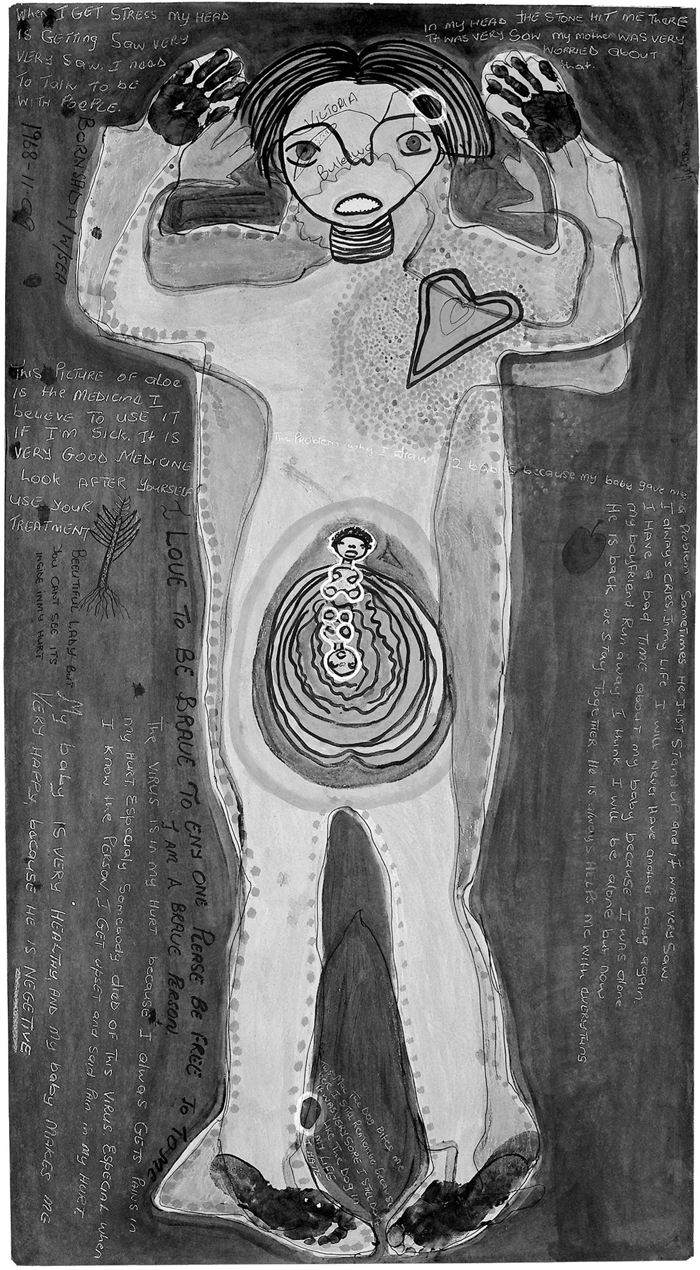 Bambanani Women’s Group, Body Maps, 2001–06. Mixed media on canvas, each approximately 72 × 40 inches. Text in English and Xhosa. Image courtesy of the artists and The Memory Box Project. Published in It Is Almost That: A Collection of Image+Text Work by Women Artists & Writers, ed. Lisa Pearson, Siglio, 2011.
Bambanani Women’s Group, Body Maps, 2001–06. Mixed media on canvas, each approximately 72 × 40 inches. Text in English and Xhosa. Image courtesy of the artists and The Memory Box Project. Published in It Is Almost That: A Collection of Image+Text Work by Women Artists & Writers, ed. Lisa Pearson, Siglio, 2011.
 Hannah Weiner, Pictures & Early Words, 1972. Typewritten manuscript pages with notations by the author. Image courtesy of Charles Bernstein and the Mandeville Special Collections, University of California at San Diego. Published in It Is Almost That: A Collection of Image+Text Work by Women Artists & Writers, ed. Lisa Pearson, Siglio, 2011.
Hannah Weiner, Pictures & Early Words, 1972. Typewritten manuscript pages with notations by the author. Image courtesy of Charles Bernstein and the Mandeville Special Collections, University of California at San Diego. Published in It Is Almost That: A Collection of Image+Text Work by Women Artists & Writers, ed. Lisa Pearson, Siglio, 2011.
Helen Kim’s work in the collection, an excerpt of What Remains (2006), speaks directly to the issue of representation. Kim’s photos and text document lunches she shared with her mother, including the spontaneous notes and illustrations her mom made during their conversations.9 The often-incomprehensible jottings are representative of both the longer, unrecorded conversations between members of a family and a cultural history as filtered through one individual’s subjectivity. The notes are a moving indication of Kim’s mother’s will to describe and represent. In turn, Kim’s use of the notes (and the communal meals that facilitated their making) in her own efforts to create and comment upon culture suggest that these thin threads of subjectivity and impression can and must be part of the public sphere. We witness another person witness, and present that to be witnessed. The way that this process can become a collective one is the promise and current failure of journalism.
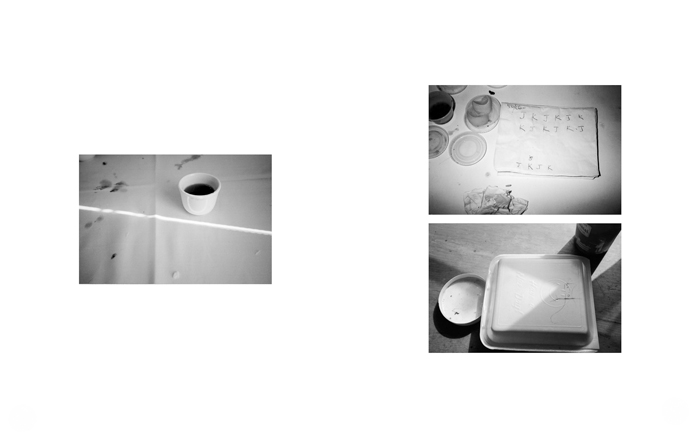
Helen Kim, What Remains, 2006. Color photographs and text, each 4 × 6 inches. Images courtesy of the artist. Published in It Is Almost That: A Collection of Image+Text Work by Women Artists & Writers, ed. Lisa Pearson, Siglio, 2011.
Carrie Mae Weems addresses the issue of visibility and a critique of rational politics in an interview that accompanies her Sea Islands Series (1991–92), which is excerpted in the collection:
…As you know, I’m a woman who yearns, who longs for. This is the key to me and to the work, and something which is rarely discussed in reviews or essays, which I also find remarkably disappointing. That there are so few images of African American women circulating in popular culture or in fine art is disturbing; the pathology behind it is dangerous. I mean, we got a sistah in the White House, and yet mediated culture excludes us, denies us, erases us. But in the face of refusal, I insist on making work that includes us as part of the greater whole.10
Much of the work included in It Is Almost That opens up the possibility of re-writing how we relate to and consume mass media, in particular the media representation of how single events fit into a greater whole. The combination of text and image has the potential to be a site for reworking the ways that we critique the myth of objective authorship and the privileging of so-called empirical knowledge. Text and image are married, forcefully and redundantly, in the realm of advertising, a field that persistently defines the formats for how ideas are presented. Journalism, where text and image are co-dependently employed to speak “truth,” is currently being called upon to present urgent information to the public—not in order to change the world, but simply to indicate adequately that the world is changing. These references for text and image art are crucial, and the questions that artists ask about how we read, speak, and connect the dots are critical ones. Inquiries about how we literarily occupy public dialogues and present our embodied needs, in order to be “read” by a society, are urgently necessary. In the interest of hybridity and leakiness, if Susan Hiller’s call to create more than just semblances of truth is combined with Carrie Mae Weems’s insistence on the importance of making visible what has been invisiblized, then the potential of image and text work is fully articulated.
Anna Mayer is an artist living in Los Angeles. In addition to her solo practice focused on sculpture and performance, she is part of the collaborative duo CamLab, which recently completed a series of social practice events at the Museum of Contemporary Art, Los Angeles, as part of its Engagement Party program. This summer Mayer will install three of her earthbag arch sculptures in the Hammer Museum’s Venice Beach Biennial.
